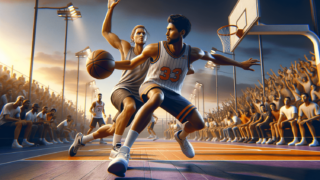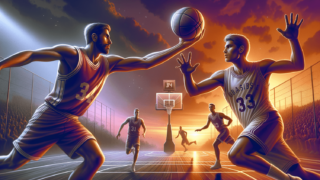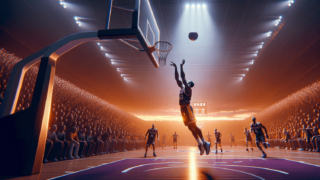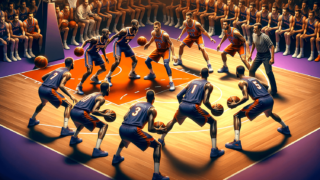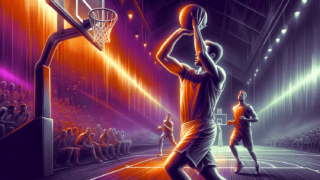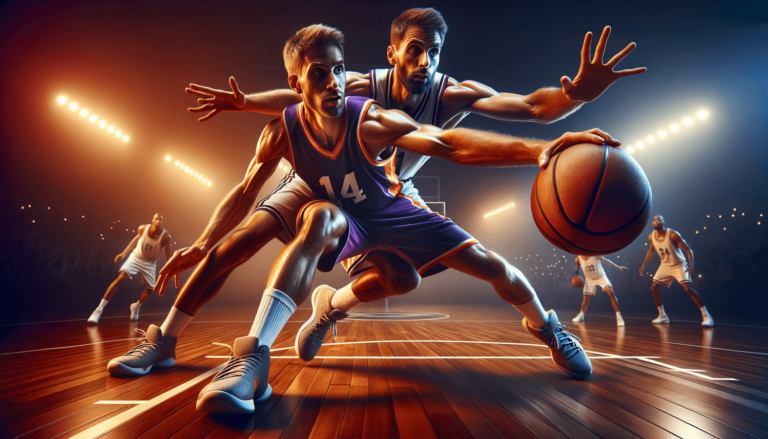
How to Improve Your Basketball Ball Pressure Defense?
Written by: Basketball Universe
Last updated:

Welcome to the exciting world of basketball defense, where ball pressure can make or break your performance on the court! If you’re eager to learn the secrets of mastering your ball pressure defense, you’ve come to the right place. With our fun and professional guidance, you’ll dive into strategies, drills, and tips that will transform your defensive game, instilling fear in your opponents’ hearts. So, dust off your sneakers and get ready to level up your skills because becoming a ball pressure defense guru is just a blog post away!
How to Improve Your Basketball Ball Pressure Defense?
Improving your basketball ball pressure defense involves focusing on the fundamentals: adopting a low and wide stance, maintaining active hands and feet, developing quick lateral movement, staying disciplined in your approach, and communication with teammates. Incorporate a mix of individual and team drills to practice these elements consistently, and add strength and agility training to enhance your physical attributes. Studying game footage and analyzing defender positioning can also provide valuable insights into effective ball pressure tactics.
The Power of Stance
When it comes to mastering ball pressure defense in basketball, positioning is key. A strong, stable stance ensures you’re ready to react quickly and effectively to any offensive move. Let’s break down the elements of an ideal defensive stance and how you can work on them.
Low and Wide
First things first, you need to get low and wide. By bending your knees, keeping your back straight, and positioning your feet wider than shoulder-width, you’ll lower your center of gravity and gain better stability against offensive players trying to blow past you. Practicing this stance regularly will make it feel more natural and help you maintain it throughout the game.
Active Hands and Feet
Hand and foot placement are integral to effective ball pressure defense. Keep your hands high and active – one hand should mirror the ball, while the other should aim to disrupt passing lanes. Quick, agile footwork is also crucial for staying in front of your opponent. Focus on staying on your toes and practicing proper footwork through exercises such as defensive slides and lateral shuffles.
Mastering Lateral Movement
Quick lateral movement is the cornerstone of any lockdown defender. It enables you to stay in front of your man, preventing drives to the hoop and forcing contested shots. Let’s explore some drills to help you boost your lateral quickness and agility.
Defensive Slide Drills
These drills train you to move horizontally and maintain your balance as you navigate the court. The classic defensive slide drill involves starting at one sideline and sliding to the other side of the court. Remember to maintain a low stance and keep your feet from crossing over as you slide. Incorporate variations like zigzag slides and timed shuttle runs to keep workouts engaging and challenging.
Agility Ladder Work
Agility ladders are great tools for developing fast footwork and honing your lateral movement. There are countless ladder drills you can perform, from the basic side straddle to more complex patterns like the icky shuffle. Practice different drills to improve your ability to change direction quickly and effortlessly. As a bonus, these drills can also help you stay nimble and avoid injuries!
Developing Defensive Discipline
Basketball requires both physical and mental strength, and ball pressure defense is no exception. Cultivating discipline in your game is crucial to avoid falling for fakes, reaching for steals, and picking up unnecessary fouls. Here’s how to sharpen your mental game:
Anticipate, Don’t React
Being an excellent defender means reading the offensive player’s moves and anticipating their actions. Studying game footage and learning common offensive tactics can give you an edge in predicting and nullifying opponents’ moves. Great defenders are often one step ahead, making it difficult for offensive players to execute their game plan.
Stay in Control
It’s vital to maintain control of your actions on defense. Falling for fakes or committing high-risk moves can lead to easy points for the opposing team. Practice staying poised and focused, especially when facing skilled offensive players. The best defenders force their opponents to adapt to them, not the other way around.
Building Team Chemistry
Basketball is a team sport, and even the most skilled individual defender isn’t enough to stop a well-coordinated offense. Improving your ball pressure defense also involves learning to work effectively with your teammates. Let’s dive into strategies and drills to maximize team defense.
Communication is Key
Open and frequent communication is the backbone of any solid team defense. Calling out screens, switches, or potential threats can save your team from giving up easy buckets. Develop a common terminology with your teammates and practice communicating during defensive drills. This will help you to quickly understand and react to situations when the pressure is on during games.
Team Drills
Incorporate team-based defensive drills into your practice sessions to build chemistry, trust, and understanding. Drills like the shell drill, where players rotate and communicate to guard multiple offensive threats, can be invaluable in developing the team’s defensive capabilities. Challenge your team to navigate a variety of offensive schemes and adapt defensively to strengthen your collective basketball IQ.
Enhancing Your Physical Attributes
Though technique and strategic know-how are crucial for great ball pressure defense, your physical attributes should not be overlooked. Strength, speed, and endurance are essential components of an elite defender, and incorporating the right training activities can elevate your game to new heights.
Strength Training
Defensive plays often involve battles for position, screens, and various forms of physical contact. Building your strength through weight training, bodyweight exercises, or resistance bands will help you remain sturdy in your stance and stand your ground against opponents. Focus on full-body workouts with a particular emphasis on lower body strength, as this is critical for maintaining your balance and power.
Conditioning
Exceptional defense requires endurance, particularly when applying consistent ball pressure throughout the game. Incorporate running, sprints, or high-intensity interval training (HIIT) into your workout routine to build your cardiovascular fitness. These exercises will enable you to continuously harass offensive players and maintain a high level of intensity on the court, leaving your competition gasping for air.
Be a Student of the Game
Lastly, don’t forget the importance of being a student of the game. Beyond physical practice, immersing yourself in basketball theory and analyzing great defenders can provide invaluable insights into the nuances of excellent ball pressure defense.
Study Game Footage
Analyzing game film, both of your own performance and of exceptional defenders, can reveal details that may otherwise go unnoticed. Observe how they position themselves in relation to the ball and their teammates, their body language, and the way they react to different offensive threats. Learn from their successes and mistakes to continuously improve your defensive knowledge and skills.
Seek Feedback
Utilize coaches, teammates, and mentors to receive feedback on your ball pressure defense. Outside perspectives can provide insights you may have missed or suggest new drills and strategies to incorporate. Embrace constructive criticism and use it as fuel to push your game’s boundaries continually.
With consistent practice, dedication, and application of these fundamental principles, you are well on your way to elevating your ball pressure defense and becoming a force to be reckoned with on the basketball court. The journey may be challenging, but the rewards are undeniable – so lace up and start today.
Staying Mentally Tough
Developing mental toughness is an essential aspect of being a lockdown defender. Maintaining focus and resilience under pressure, not letting mistakes get you down, and bouncing back when things don’t go as planned are crucial skills for stellar ball pressure defense. Here are some strategies to help you develop a strong mental game:
Embrace Challenges
See every challenge as an opportunity to learn and grow as a player. Whether you are tasked with guarding the opponent’s star player, or you find yourself in a tough situation on the court, use these moments to demonstrate your determination and adaptability. The more you take on challenges, the easier it gets to keep a clear head and maintain confidence when the stakes are high.
Visualize Success
Creating a strong mental image of yourself rising to the occasion and outperforming your opponent can be exceptionally motivating. Studies have shown that visualization can positively impact athletic performance. Take a few minutes each day to visualize yourself dominating on the defensive end, executing perfect ball pressure defense, and shutting down the opposition.
Offensive Skills Matter
While this article is predominantly focused on improving your ball pressure defense, it’s important not to neglect your offensive game. A well-rounded player is a greater asset to their team, and working on your offensive skills can benefit your defensive capabilities as well.
Understanding Offense to Improve Defense
One often-overlooked aspect of basketball is how understanding offensive strategies can help enhance your defensive game. Comprehending an opponent’s offensive movements allows you to anticipate plays better, thus positioning yourself more effectively on defense. Practice different offensive moves yourself and study how they are executed, as this knowledge will improve your ability to negate them during a game.
Drills for Individual Defense
So far, we’ve explored several aspects of ball pressure defense that can be improved by incorporating team-based defensive drills. Now, let’s focus on a few key drills that develop your individual defensive abilities as well. Implementing these drills regularly will result in noticeable improvements in both one-on-one defense and overall ball pressure prowess.
Closed-Out Drill
The closed-out drill is an essential practice for developing excellent footwork and understanding body positioning. Start under the basket and sprint out to contest a shot, then get into a low defensive stance and slide to the baseline. Repeat this at various spots around the three-point line. As you close out on shooters, remember to maintain a balanced body position and use your hands effectively to contest the shot without fouling.
One-on-One Full Court
Playing one-on-one full court can help improve both your stamina and defensive instincts. By constantly practicing against offensive players in a full-court scenario, you’ll enhance your ability to press the ball up and down the floor. Modify the game rules as needed, such as providing a time limit to get the ball across half-court, to add extra challenges and hone your ball pressure defense even further.
By incorporating this additional information into your defensive arsenal, you’ll continue to build upon the fundamentals and techniques previously discussed, leading to a well-rounded and rock-solid ball pressure defense that will be the envy of teammates and opponents alike. As you craft your own, unique defensive identity, remember that progress takes time, but dedication, focus, and hard work will ensure success both on and off the court.
FAQ Section: Ball Pressure Defense
We understand that learning and implementing ball pressure defense can raise questions and concerns. In this FAQ section, we’ve compiled a list of common questions to help guide your journey in becoming a lockdown defender.
1. What is the importance of ball pressure defense in basketball?
Ball pressure defense is crucial for disrupting the opponent’s offensive flow, forcing turnovers, and preventing easy scoring opportunities. It helps teams gain momentum in the game, as well-executed ball pressure defense can lead to fast breaks and energize teammates and fans.
2. How do I force my opponent to pick up their dribble?
To make an offensive player pick up their dribble, apply pressure by maintaining a low, athletic stance, and active hands. Keep your chest close to the offensive player without fouling, and try to force them into an uncomfortable position or angle, limiting their options and encouraging them to pick up the ball.
3. How can I avoid fouling while applying ball pressure?
Avoid fouling by being disciplined and maintaining proper body control. Keep your hands high and active without swiping or reaching for the ball unnecessarily. Additionally, use your feet and hips to maintain position while staying in contact with the floor, rather than leaning or lunging.
4. How does ball pressure impact team defense?
Effective ball pressure can disrupt the offensive flow, resulting in turnovers, poor shot selection, and increased frustration for the opposing team. It also positively impacts team chemistry and communication, as it requires seamless coordination and collaboration among teammates to execute.
5. What is the role of communication in ball pressure defense?
Communication is essential in ball pressure defense, as it helps teammates recognize and react to various threats that arise during a game. Clear, constant communication between players informs about screens, switches, and potential threats, allowing the team to react quickly and efficiently.
6. I’m not naturally quick or agile. Can I still be effective at ball pressure defense?
Yes, while physical attributes like speed and agility are helpful, they’re not the sole determining factors in one’s defensive success. By focusing on improving your stance, positioning, anticipation, and communication, you can compensate for any perceived physical limitations and become a formidable defender.
7. How can I improve my lateral movement for better on-ball defense?
Develop your lateral movement by incorporating drills such as defensive slides, lateral shuffles, and agility ladder exercises in your training regimen. These drills will help you become more fluid and efficient in your side-to-side movement, enhancing your on-ball defensive capabilities.
8. What are some good drills for practicing ball pressure defense?
Effective drills for ball pressure defense include the shell drill, closed-out drill, defensive slide drills, one-on-one full court, and various team-based exercises. These drills focus on improving footwork, positioning, communication, and anticipation, essential components of ball pressure defense.
9. Can I apply ball pressure defense without knowing my opponent’s offensive strengths and weaknesses?
Yes, but knowing your opponent’s strengths and weaknesses can significantly enhance your ability to apply effective ball pressure. Studying game film, analyzing player tendencies, and understanding different offensive strategies will enable you to make informed decisions when playing defense, allowing you to “read” your opponent and anticipate their actions.
10. How can I inspire my teammates to commit to ball pressure defense?
Encourage teammates to embrace ball pressure defense by emphasizing its benefits for the team, such as generating steals, forcing turnovers, and creating fast-break opportunities. Lead by example, be vocal and supportive, and showcase your lockdown abilities to inspire your team to join your defensive efforts.
Featured Posts
- No pillar pages found.
